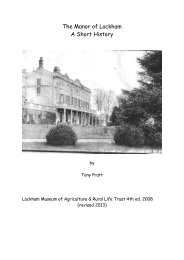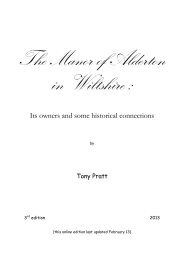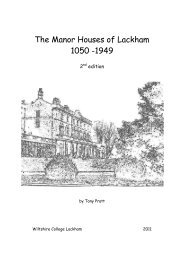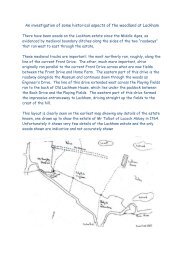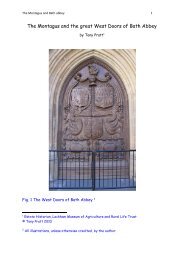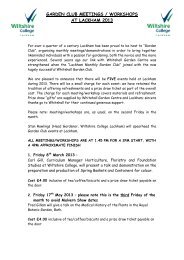History of Agricultural Education in Wiltshire - Lackham Countryside ...
History of Agricultural Education in Wiltshire - Lackham Countryside ...
History of Agricultural Education in Wiltshire - Lackham Countryside ...
You also want an ePaper? Increase the reach of your titles
YUMPU automatically turns print PDFs into web optimized ePapers that Google loves.
1914 -1918 World War I.<br />
Tractors began to replace horses on the farms and 3,000,000<br />
acres <strong>of</strong> grass ploughed up to <strong>in</strong>crease food production.<br />
1920 <strong>Agricultural</strong> Wages Board fixed m<strong>in</strong>imum wage for farm workers.<br />
1927 <strong>Agricultural</strong> Land Commission, compensation for disturbance etc.<br />
1931 <strong>Agricultural</strong> Research Council formed.<br />
1932 National Federation <strong>of</strong> Young Farmers' Clubs formed with head<br />
quarters <strong>in</strong> London.<br />
1933 Formation <strong>of</strong> Milk Market<strong>in</strong>g Board and several sugar beet<br />
factories erected.<br />
1939 Declaration <strong>of</strong> World War II.<br />
1940 War <strong>Agricultural</strong> Committees formed <strong>in</strong> the counties to <strong>in</strong>crease<br />
food production. The <strong>Agricultural</strong> <strong>Education</strong> staffs were seconded<br />
to the War <strong>Agricultural</strong> Committees.<br />
With grant aid by the Board <strong>of</strong> Agriculture follow<strong>in</strong>g the Technical Instruction<br />
Act <strong>of</strong> 1889 and the 'Whisky 1 award <strong>of</strong> £75,000, seven Universities and two<br />
<strong>Agricultural</strong> Colleges received grants to carry out <strong>Agricultural</strong> Research and to<br />
tra<strong>in</strong> teachers and advisers for Local Authorities. Only four Farm Institutes<br />
were established at this stage. The development <strong>of</strong> Farm Institutes was slow<br />
and the whole system was reviewed <strong>in</strong> 1908 by Lord Reay and his Committee. It<br />
recommended that an <strong>Agricultural</strong> Organiser should be appo<strong>in</strong>ted <strong>in</strong> each county<br />
to advise farmers and appo<strong>in</strong>t <strong>in</strong>structors <strong>in</strong> Horticulture, Poultry, Dairy<strong>in</strong>g and<br />
Beekeep<strong>in</strong>g. The Organiser should be attached to a prov<strong>in</strong>cial centre <strong>of</strong> Higher<br />
<strong>Education</strong> e.g. <strong>Wiltshire</strong> should be l<strong>in</strong>ked with Bristol University.<br />
In 1911, the Development Committee provided large sums <strong>of</strong> money for further<br />
development <strong>of</strong> research <strong>in</strong> Universities and <strong>Agricultural</strong> Colleges and advisory<br />
work <strong>in</strong> the counties. In 1939, there were:<br />
8 Prov<strong>in</strong>cial Centres<br />
7 Universities<br />
7 <strong>Agricultural</strong> Colleges<br />
13 Farm Institutes




